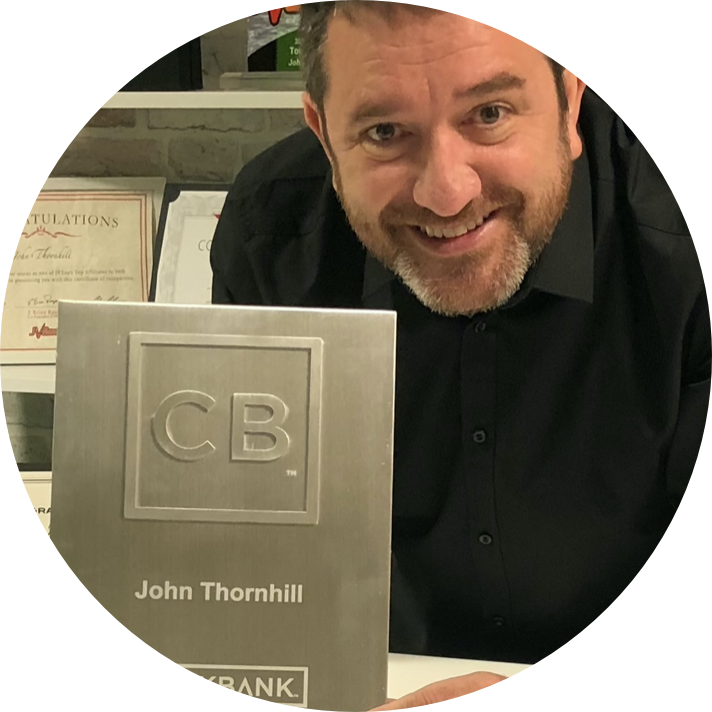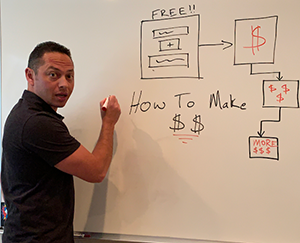Gain Freedom From the Fear of the Future: How to Thrive in an Uncertain World written by John Jantsch read more at Duct Tape Marketing
The Duct Tape Marketing Podcast with John Jantsch In this episode of the Duct Tape Marketing Podcast, I interviewed Dr. Frederik Pferdt, Google’s first Chief Innovation Evangelist and a renowned expert on innovation and creativity. Frederik Pferdt helped shape one of the world’s most fabled creative cultures. He founded Google’s Innovation Lab, where […]
Transform Your Business with the Metronomics Framework written by John Jantsch read more at Duct Tape Marketing
The Duct Tape Marketing Podcast with John Jantsch
In this episode of the Duct Tape Marketing Podcast, I interviewed Shannon Susko, a strategic business coach and author renowned for her innovative Metronomics framework. Her expertise lies in transforming businesses through her unique growth operating system, helping leaders achieve sustainable growth and balance. Beginning with the Metronome effect, In our conversation, Shannon Susko defines the Metronomics framework and explains how it can revolutionize the way CEOs and leadership teams approach growth, strategy, and execution.
Key Takeaways
Questions I ask Shannon Susko:
[01:55] How did your journey as a CEO form the Metronomics framework?
[03:08] Would you say, like most entrepreneurs, you went well-informed to gain the success you have today?
[05:06] How did you develop the term ‘Metronomics’?
[08:01] How is this different from other growth frameworks?
[10:45] As a CEO, how do you keep the momentum of the Metronomics Framework going?
[17:54] As a business coach, how big of a hurdle is the CEO and their inability to “let go”?
[19:33] Is there anywhere you want to invite people to connect with you or find out more about your work?
More About Shannon Susko:
- Connect with Shannon Susko on LinkedIn
- Visit her Website
- Grab a Copy of Metronomics: One United System to Grow Up Your Team, Company, and Life
Like this show? Click on over and give us a review on iTunes, please!
Connect with John Jantsch on LinkedIn
Speaker 1 (00:00): I was like, I found it. I found it. This is what I’ve been looking for. I can honestly say it has genuinely changed the way I run my business. It’s changed the results that I’m seeing. It’s changed my engagement with clients. It’s changed my engagement with the team. I couldn’t be happier. Honestly. It’s the best investment I ever made. What
John Jantsch (00:17): You just heard was a testimonial from a recent graduate of the Duct Tape Marketing certification intensive program for fractional CMOs marketing agencies and consultants just like them. You could choose our system to move from vendor to trusted advisor, attract only ideal clients, and confidently present your strategies to build monthly recurring revenue. Visit DTM world slash scale to book your free advisory call and learn more. It’s time to transform your approach. Book your call today, DTM World slash scale.
(01:03): Hello and welcome to another episode of the Duct Tape Marketing Podcast. This is John Jantsch. My guest today is Shannon Susko. She is a celebrated for her strategic prowess team leadership and financial acumen, having successfully co-founded Lead and sold two companies. Within six years. She developed the Metronomics framework fostering rapid growth and successful exits, and now she coaches CEOs and is the author of a number of acclaimed books, including metronomics one United System to Grow Your Team, company and Life. So Shannon, welcome to the show.
Shannon Susko (01:38): Yeah, thanks, John. Great to be here.
John Jantsch (01:40): You had a lot of hard words in your bio that I almost tripped over several times. I don’t
Shannon Susko (01:45): Know where that bio came from, John. I was like, so who is that person? Is someone on my team is working the word magic.
John Jantsch (01:55): So let’s just start with Metronomics. What was the genesis of it? How did your journey as a CEO form it?
Shannon Susko (02:04): Yeah. Well, it started in my first company. Metronomics has been around for 24 years. It’s a growth operating system, and it’s one that we built out a pure, desperate need to figure out how to unlock a way to grow a company and have fun doing it. And so it was our first business. We were stuck and we decided with my leadership team that we brought in from all over the world, I said, there must be a system. I asked my coach, you’ve got to have a system, right? Repeatable system. How are we going to do this? And you know what? My coach of all he’d already built, grown, sold many companies, and I say many because I don’t even know how many. And he’s like, yeah, no, you’re doing the right things. You’re learning from the right people. Keep going. And I was like, no, we got to find a way. So that’s where Metronomics came from. It’s a growth operating system to save leaders time and get them having fun in their business, get them outside the business, find the balance.
John Jantsch (03:08): So I don’t know if I would call you a business book junkie, but Yes, yes, I am. I hear you reference a lot of books and a lot of names that are people that I know. Would you say that all good entrepreneurs, that a lot of those people informed where you ultimately ended up?
Shannon Susko (03:25): Yeah, I mean, absolutely. When I was asking for the system, I kept asking, there’s got to be a system. Give me the book for two years, 24 months. I read four books a week because I actually didn’t believe there wasn’t a system. And so in doing that, and then, yeah, I haven’t stopped reading books. I still read a book a week at this point, not four, but at least a book a week. But you know what? All the great thought leaders out there, Jim Collins, Michael Porter, and all the genres and all the different systems in the business, they all gave us the what, right? And so you’d learn the what, and you’d go over and do that, and you’d play Whack-a-Mole on the cultural system, or you’d play Whack-a-Mole and the human system or the strategy system, but none of them were connected. And I was like, okay, we got that fixed. Now this broke run over here, run another. So we took all those great things and we actually plugged them into the system. It’s like when you think of my background’s technology, so when you think of a computer operating system that’s running Mac or Windows, many things plug into it, but it’s like the system that works day in and day out. That’s what Metronomics is. And we love taking all the different things that companies need and we plug it in when it’s needed.
John Jantsch (04:53): So I’m curious about the term where you landed on, I’m envisioning Sister Colette, my first grade piano teacher and the metronome metaphor. So how did you come to Metronomics is the term?
Shannon Susko (05:09): Yeah, well, funny enough, first book is called the Metronome Effect. And when I wrote that book, finished the book, finished it all, couldn’t think of a name. I checked all these names, went out for a run, and there’s a metronome on my Garmin.
(05:27): And I was like, oh, that’s really interesting because the metronome sets the speed at which you’re going to run, play the piano, and the CEO is the metronome in a business. They set the speed at which you’re going to grow your business. So that’s where metronome came into play. I did have a piano teacher as well. I did all those grades. I did have it sitting up on the piano, but it made me think that day, okay, you set the speed and you must hold that speed or rhythm or whatever it is. So that’s where that came from. Metronomics came from the word metronome, which represents the CEO, who gets to set the speed. We want a consistent speed in the organization, not one that goes fast and slow, fast, slow. So economics is the other word. And it was really about the balance of your life and your business, your economics, balancing your time with the dollars.
(06:22): So there’s a whole piece that we have in there, but that’s what I was fighting, is balancing teen business and life. So that’s where the economics piece came from and there’s definitely a method to that madness. And then the third word, and there’s a fancy word for how we made up this word, I don’t remember it today, but I know it’s in the last chapter of omics, the book itself. But it’s metrics and metrics. What we learned are not the things you track, it’s the things you forecast and the things you control that flow through your business. And so everybody who works on a team in a business owns a thing. They do a thing every day, and there’s so many of those things they do every day, and we call them widgets. So a metric represents a widget. And so those three words made up metronomics, which is this big long word, and maybe we shouldn’t have made up that word, but we did because it represented the things that flow through the business, represent the team that needs to connect to them. The metronome represents the CEO and the economics is the outcome you get, which is balancing your business and your life because most CEOs, especially startup CEOs, but even when you get to eight, 10 years, people are tired of the same old one. They can’t seem to unlock it. And this unlocks it, right? It gets you back your life so you have fun again and gets you the team you’ll want to work with.
John Jantsch (07:51): So you mentioned a couple of names, Jim Collins, Vern Harnish, Gino Wickman. I mean of all people that you recognize the names of creating similar systems. If somebody said, how are you different or how is Omic different?
Shannon Susko (08:06): It’s a great question, John, because I grew up on the late nineties on Rockefeller Habits, which was wearing Harish and learning pieces of that, and we had pieces of that. And then Gino’s work where the EOS came out later, but he grew up at the same time with rock habits. And if you take great game of business, Jack Stack and all the mini games that happen, they’re all very much influenced in all of this. And we put those pieces in place. We created the cash system, we created the execution system, we had the cultural system, we had those pieces, but there was still a gap in the middle. And the gap was the strategy and the strategy system. And the biggest difference is that by having your 10 to 30 year goal and having your annual goal, which scaling up EOS is great, they’re great execution and cash systems, and they line up with the long term, our three year highly achievable goal.
(09:09): That’s the difference. That’s the thing that connects your long term to now, and it’s so close, you can reach out and touch it. It’s 12 quarters, but you must lay out the execution quarter over quarter, 12 quarters straight to get there. And the system itself, the strategy system, not we know these days is not like, oh, we create a strategy, our five year strategy, it’s happening strategy we have to talk about every day, week, month, quarter, year. And this allows us to give that connection and the alignment to the team and that word widget and that word metric in regards to a three year highly achievable goal connects your team to where you’re going. It connects everybody in the company to the overall team results. And that’s the difference. Now, do we love a company? I love a company doing EOS, and they usually get to a point where they need to look further that strategic piece, and we just layer right on top of it. If you’re doing scaling up, Metronomics will layer right on top of it. It takes everything they’ve learned about a discipline execution system with a little bit of strategy and some of the cultural pieces and just puts it onto a little bit more of a timeline. Rocket ship of three years. It really challenges it.
John Jantsch (10:36): I dunno if this is the deliverable or the objective is to create kind of this repeatable playbook that the whole company uses. How do you stop that? How do you keep that alive? As I listened to you talk about it, so many people create systems and playbooks and nobody can actually even find the darn thing anymore a week later. So how do you keep that thing alive?
Shannon Susko (10:55): Yeah, so the way you keep it alive, you can write it down, you can have it out, and everyone goes, oh, isn’t that wonderful? And then nobody does it. At the end of the day, metronomics is about behavioral accountability, and at the end of the day it’s about behavior with your team on the field. And we actually created a field, a virtual field. It’s a behavioral accountability platform that is called, we call it Metro, the company. It’s in as metronome growth systems, but it is the metronome in the platform. Everybody logs in to the platform every day, and a lot of people go every day. They look at what they said they would do, they look at the cadence at which they set it. All the meetings are run through that platform day, week, month. And it really starts with how does the playbook stay alive?
(11:47): Well, number one, a coach that understands the playbook, so I’ll put my coach hat on for a second, but at the end of the day, it’s the CEO O with the leadership team, commits to the team habits, the team habits of the playbook, and that’s what keeps it alive. When the ceo, EO and the leadership team don’t want to do those habits anymore, the playbook, we evolve the habits, but they don’t want to do it anymore. The playbook is just a really nice system sitting there that no one will use. And as well as I know in any business, a system is only as good as the users of the system. You got to use the system to keep it alive.
John Jantsch (12:29): Well, and that was really going to be my next point. I mean, a lot of what I think stops great companies is that they get to a certain point where building a leadership team is different than managing a company. And so how do we evolve with this, right? We build the playbook, it’s awesome, but now we’ve got new problems.
Shannon Susko (12:51): So the interesting thing is we have the seven systems that all connect to one another and they exist in any business, whether you want to acknowledge them or not. That’s one of the biggest things I learned early on in business. But the thing that we found in Metronomics and with the research we’ve done over the last 14 years is that there’s three phases of growth that every company will be in at some point and some may never get out of the first phase, which is the foundation phase. It’s the very first phase. There’s five things that we’ve really got to pull the lever on to move from the foundation growth phase to the momentum growth phase. The third growth phase is the compounding growth phase. Most companies, whether it’s called that or not, it doesn’t matter. Most companies get stuck there because it’s a willingness to have a repeatable cash system and put the effort in to forecast cash first, have an execution system that works without the leaders, but in order to have that, the leadership team must be, it’s the CEO plus all the functional leaders that we have in companies, and it has to be whatever the definition of that team is, a hundred percent A players.
(14:10): And the last thing is it must be cohesive in order to get that far. While we’re doing all that in the foundation growth phase, we’re mapping the strategy and to keep it all aligned. Mapping the strategy gives us strategic pictures, whether we have all those other things working or not. We can still map our strategy, but it’s lining all those things up so that I always say, it doesn’t make it easy. It creates some ease, it takes some pressure off. We get some growth results just from picking off each one of those things, which actually brings the team back to keep doing it, that actually will take the team through to the other side and really grow the system. I always say the playbook meets you where you are. And so I go into companies and they have an A player leadership team. It’s cohesive.
(15:06): They have a cast system and they have a great execution system that’s working without them. I go, fantastic, let’s get the workout strategy. Because what they’re looking for, others come in that phase and they may have a couple of those things, but they might be stuck on that. A player leadership team. It depends how that team is formed, but we’re going to meet the teams there and that keeps it alive in the phase that they’re in. And then as they pick off the critical path, we know there’s a critical path for growth. We will move to the momentum phase, which you got to keep all those things alive in the foundation phase. Then we got to validate with confidence and strategy so that we can make better foster decisions to keep up with the speed of growth of the organization. We need to take the leadership team to that next level of cohesiveness.
(16:01): I call it team trust 2.0, but it’s where they’re at the point now that they have the time to coach their team, work on strategy and grow themselves into Jim Collins would call the level five leader Bill and Bob, Adam, scaling leadership would call it integral leadership. But it’s actually that next version of the leaders. They have time to grow themselves at the rate the company’s growing. And of course the last phase is compounding. We see companies go into the compounding phase top line, and they can’t sustain it, right? Because the thing that all those things have to be true in the first two phases. The last phase is you got to basically what we call the coach cascade system. You’ve got to cascade out the growth and learning of your team members in order to keep up with the growth of the company. And those are the things.
(16:57): That’s why some of the clients I’ve had for 11 years, and someone goes, have they not got it yet? But the playbook has evolved as they have evolved, and it’s really fascinating to me. It’s really fascinating, but very much reflects my tenure journey and my first company where it’s not a straight line across the growth phases. And once you get there, it’s not that you necessarily always stay there. The external environment can push you back. Your team coming and going can push you back, right? Your strategy can push you back. So yeah, it’s really exciting to actually put this in place and a team gets so good at it, they forget about it, they forget about the system, and then they’re just thinking within their business, but following the cadence.
John Jantsch (17:46): So I’m tempted not to ask you this question because we are close on time, but I know it’s a big one. How big of a hurdle is the CEO and their inability to let go in your work?
Shannon Susko (18:02): Yeah. I love working through the phases of this with a CEO EO because, and what I call a desperate CEOI was a desperate CEO. My coach could have said, stand on your head Shannon and spit out nickels, and that will get you there faster. I probably would’ve done that. And there’s different levels of desperation on how bad you want to win whatever winning is for that company. And so what I find is CEOs will, I was on a call earlier this morning and they do whatever. They’ll follow that system because of where they want to go. So I always say it’s how bad does that CEO EO, and I’m going to go plus leadership team want to win their game. That is how fast a CEO let go of things. And once they start letting go take off the sales hat and give it to someone else and take off the finance hat and give it to someone else, and they see the time, they get back to doing the things that are in their sweet spot, it goes a lot faster. But it’s just got to give ’em a little inkling of what it might be to let it go. But they’ve got to want to, there’s lots that don’t. They think everything’s great, and if they think it’s great, then it’s great, and they’re going to grow along at one to 3% a year and fantastic. As long as they’re having fun, life’s too short.
John Jantsch (19:28): Absolutely. Well, Shannon, I appreciate you taking a few moments to stop by the Duct Tape Marketing Podcast. Is there anywhere you would invite people to connect with you and find out more about your work?
Shannon Susko (19:37): Yeah, you can absolutely just look me up on LinkedIn, Shannon Byrne, Susko on LinkedIn Easy, although I think the only one out there with that name and as well on metronomics.com, everything’s there. Lots of free resources, webinars. Yeah, please come and join our community if you’re interested.
John Jantsch (19:56): Awesome. We got a Canadian resources there too, just to put a little fine point on that.
Shannon Susko (20:01): Yeah. Oh good. Yeah, absolutely.
John Jantsch (20:04): Awesome. Again, well hopefully we’ll run into you one of these days out there on the road.
Sign up to receive email updates
Enter your name and email address below and I’ll send you periodic updates about the podcast.
Recommended Story For You :

How To Make $3493 Commissions Without Doing Any Selling

Successful dropshippers have reliable suppliers.

People Think I Use A Professional Voiceover Artist. NO! I Just Use Speechelo!

Make Money Testing Apps On Your Phone Or Tablet

Make More Money or Lose Everything

Sqribble Is The ONLY eBook Creator You’ll Ever Need.

Work & Earn as an Online Assistant

Create Ongoing Income Streams Of $500 To $1000 Or More Per Day




